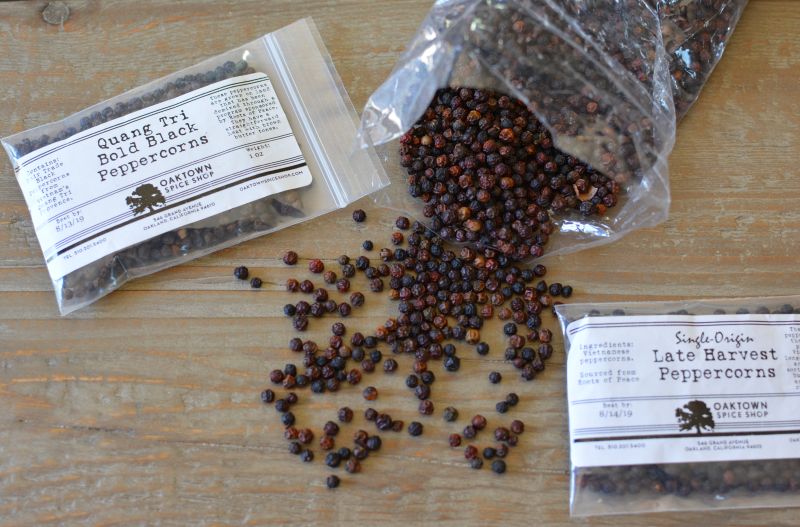
Chile peppers play an important role in Vietnamese cooking but in our family, black pepper was equally important, if not more so than the fleshy hot fruit. We didn't have access to Vietnamese pepper for decades but that didn't stop my mom. She used what was available and always sprinkled black pepper on top of brothy canh (everyday quick) soups, stir-fries, and noodle soups like pho. The spice injected a final flavor burst. The pungent heat of black pepper worked its magic on dumpling fillings and banh mi. I didn’t think much about Piper nigrum, especially Vietnamese pepper until I went to Phu Quoc island years ago and learned about its famous peppercorn farms. (Yes, PQ is known for fish sauce as well as pepper!)
In Vietnam, pepper farms are called vườn tiêu (peppercorn garden), easily identified by the tall columns of bushy pepper vines.
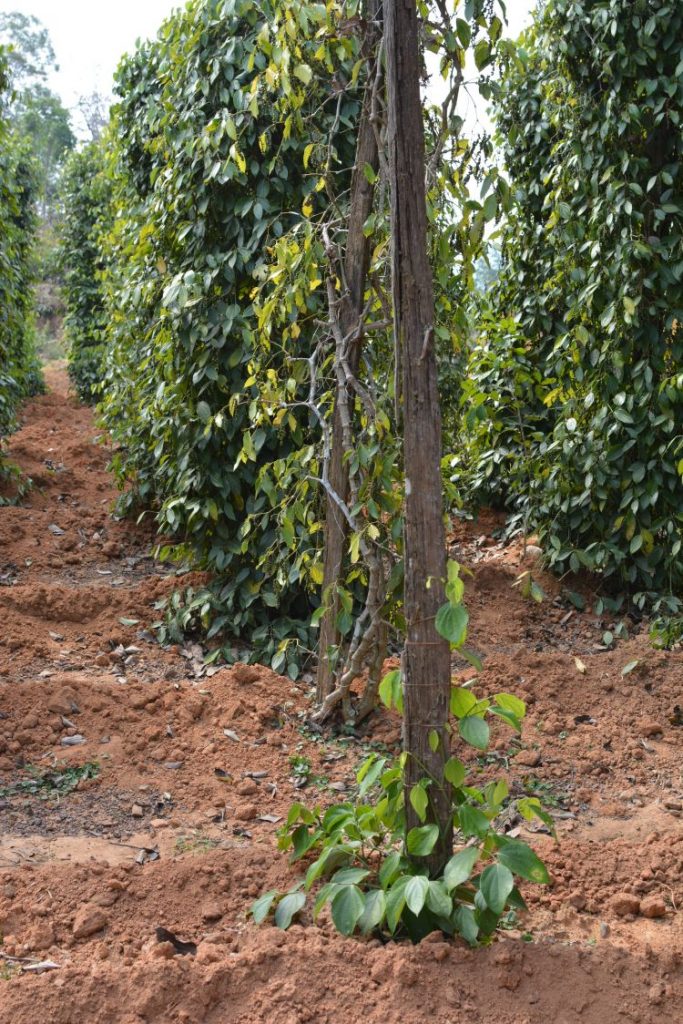
The Vietnamese pepper vines look funny, like they could walk into a Maurice Sendak children’s book. The soil on Phu Quoc can be sandy and the pepper vines wind around poles to keep their fruits well exposed to the sun. The fruits grow as long cluster. Each fruit is technically called a drupe.
Most of what we eat is black pepper but the fruits have different flavors at different times of maturity. Unripe clusters of jade-green peppercorns are amazing enjoyed raw, as an accompaniment to food. Not as hot as their mature, dried kin, they also lend zing to earthy dishes like fish simmered in caramel sauce, which I’ve had on Phu Quoc several times. A Viet chef at the Sofitel resort on the island said he liked to use green peppercorns with beefsteaks for a local twist on French steak au poivre (peppercorn steak).
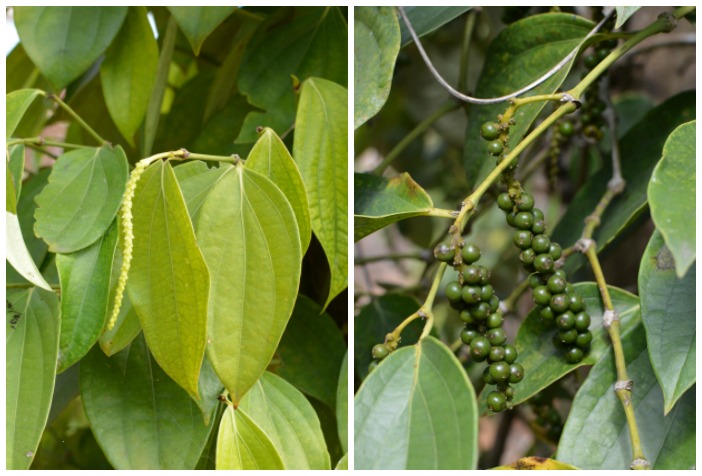
In America, you can get green peppercorns in brine – imported from Thailand. They’re okay but not as thrilling as the green pepper plucked off the vine.
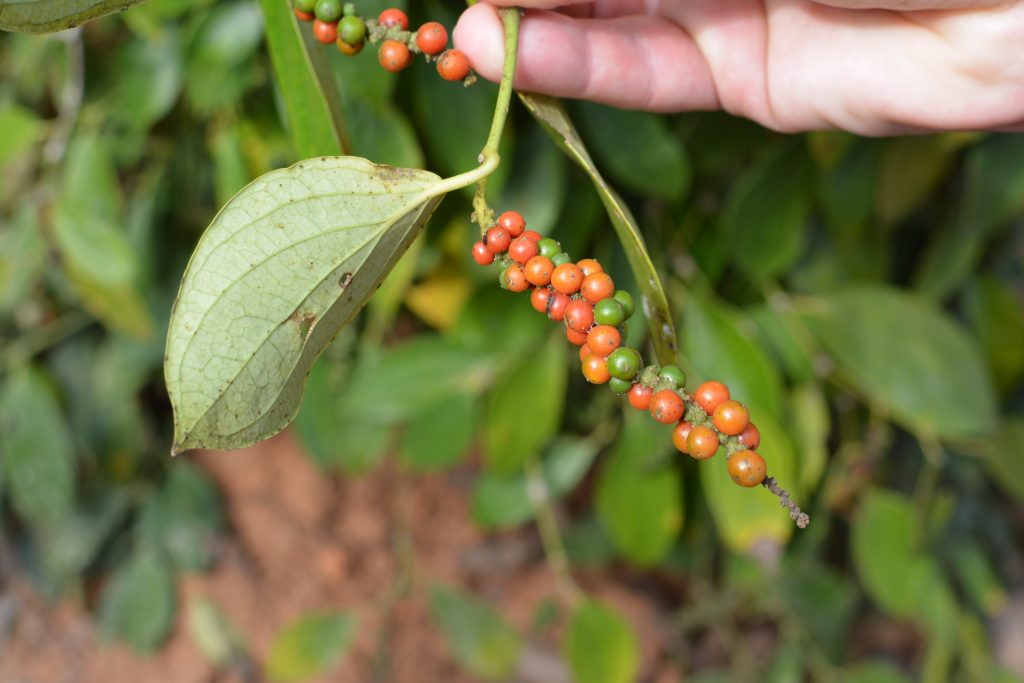
Pepper changes color and flavor as it matures. On Phu Quoc, pepper is hand harvested and sorted, then left to dry in the sun.
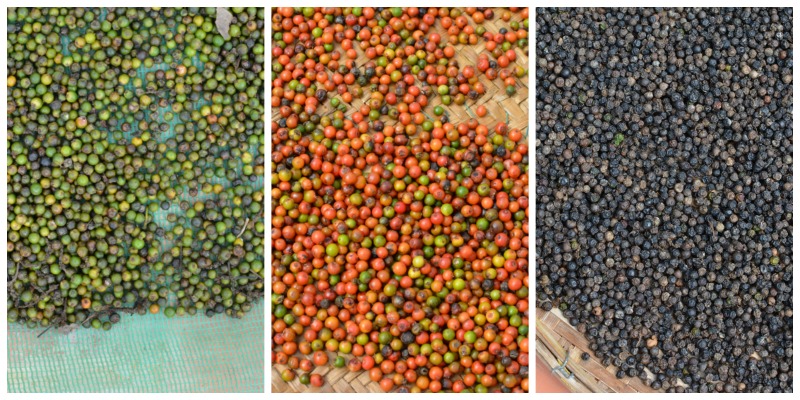
The highly-prized reddish peppercorns are ripe and have a sweet, citrusy heat that’s similar to Cambodia’s Kampot pepper. Compared to the famed Indian Tellicherry peppercorns, the Phu Quoc variety is not as spicy hot.
I tend to use more of Phu Quoc's Vietnamese pepper than normal as its more subtle pungency plays well with other ingredients. The island's pepper has complex, nuanced flavor. Whenever I go to Vietnam, I buy pepper and ask for the red kind from Phu Quoc. I’ve had friends hand carry the green peppercorns back for me, too.
Do you have to go to Vietnam to get good peppercorns? Nope. Whole Foods's regular 365 peppercorns are from Vietnam; the exact origin isn't specified but it has nice floral heat. (The WF organic pepper comes from India.) For rarefied and truly curated pepper, peruse a spice vendor’s offering.
A few spots where I’ve shopped for pepper: Curio (Sommerville, MA), Oaktown (Oakland), La Boite (NYC), Market Spice (Seattle), Penzeys (many locations) and Spice Station (Silver Lake/Los Angeles). Peppercorns offer terroir – a sense of place, so try difference kinds from different locales. The Quang Tri pepper in the top photo, for example, tasted different than the Phu Quoc pepper.
And, though I've covered Phu Quoc pepper in this article, don't limit yourself. I surely don't. Just look further down to see what's in my cupboard at the moment.
When shopping for pepper, "Late harvest" should mean the ripe drupes. "Extra bold" refers to select peppercorns with outstanding big flavor. A good spice vendor should explain the terminology to you. There are few standard descriptions of pepper.
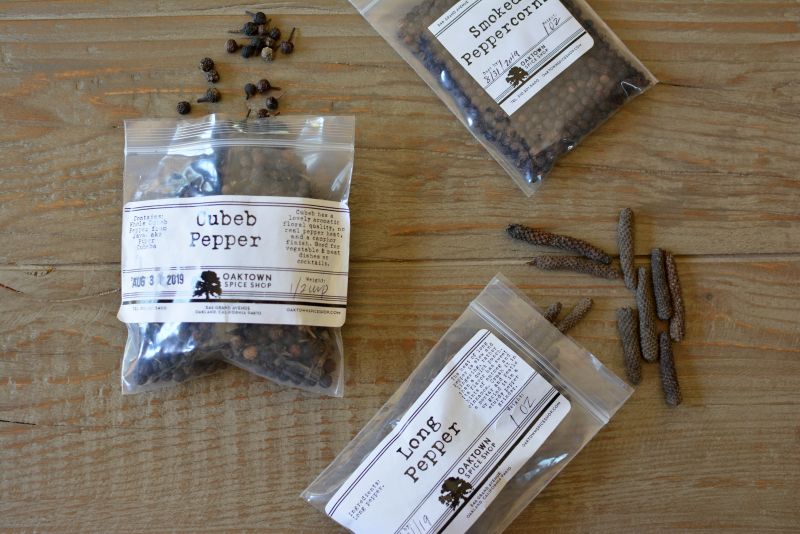
Aside from regular black peppercorns, check out others, like Cubeb (has notes of mace and nutmeg) and Long pepper (woodsy and spicy sweet, the favored pepper before the little round ones took over in popularity). And there are smoked and flavor-infused peppercorns, though I've yet to find any that are super punchy the way I imagine they should be.
What are not true peppers? Sichuan peppercorns and pink peppercorn, for example, come from other plants. They're certainly fun to use but are botanically not in the Piper nigrum family.
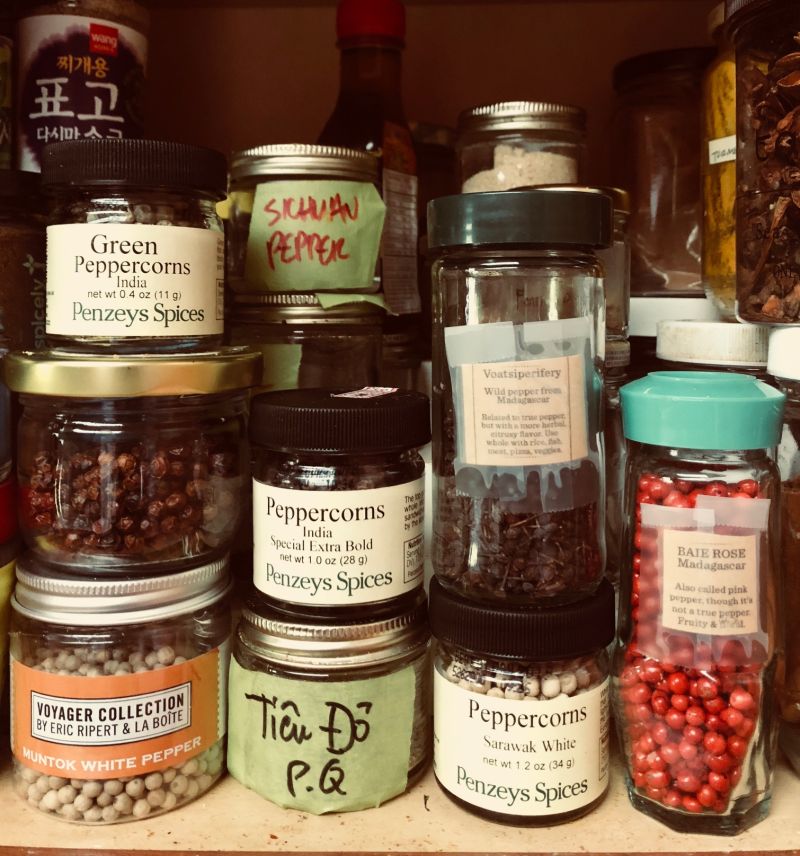
What about pre-ground pepper? Purchase and use it only if you trust the source. What’s sold as pepper in a jar or can rarely has zip. Spice expert Lior Lev Sercarz writes in his book that pre-ground pepper may involve “a lot of adulteration” including ground olive pits (!!). It’s not a health danger but you’re not getting peppy pepper.
How to store and grind pepper? I keep mine in the freezer. For garnishing a salad with finesse, I grab this pepper grinder. But for recipes, I use recently ground pepper that I’ve whizzed up in a cheap coffee grinder dedicated to spices. I do not expect home cooks to hand grind ¼ teaspoon of pepper. Life is too short. Just grind up a few tablespoons at a time and keep in a jar.
Vietnam is among the world’s leading exporters of black pepper but the remarkable peppercorns from Phu Quoc and elsewhere are still relatively unknown. When you’re in country, visit the Vietnamese pepper farms to witness the hand harvesting, sun drying and sorting. Buy some to take home. When you’re not in Vietnam, keep your eyes out for it.
Regardless, pay more attention to pepper. It's should play second fiddle to salt!
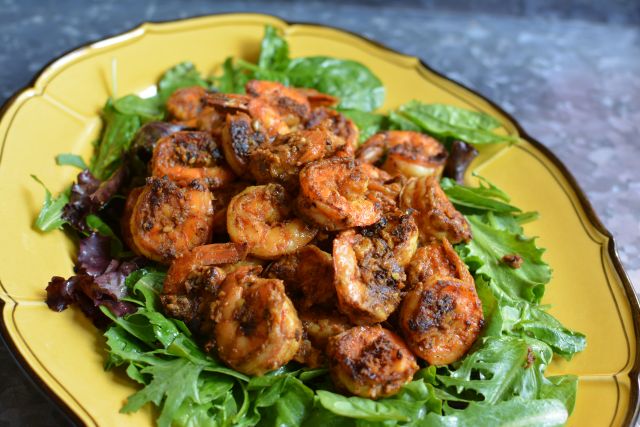
Want a pepper-centric recipe?
- Try this Goan spice-rubbed shrimp dish that I made for my April column in Cooking Light magazine. Goa is on the Malabar Coast, where pepper proliferates. For more pepper history and lore, read the Cooking Light article.
- Stir-Fried Beef with Black Pepper (a Chinese classic!)
- Cilantro Peppercorn Pesto (a Thai wonder to keep on hand)
Pho Cookbook News!
Look at that! In February, the book made two bestseller lists! On the Wall Street Journal's list, The Pho Cookbook was the seventh (7th!) bestselling non-fiction book. That’s never happened to me before and I’m totally stoked. My editor told the other day. I was in the middle of doing taxes so the news brought waves of cheer! Thanks for your pho-tastic support! This is definitely a career high point.
Where do you shop for pepper?













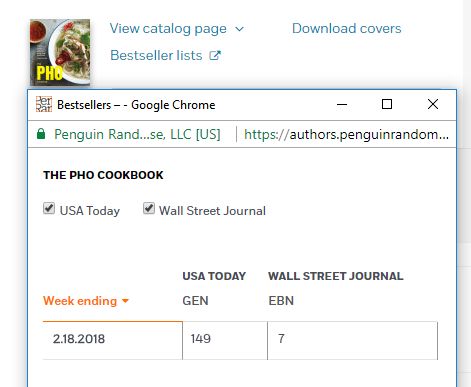


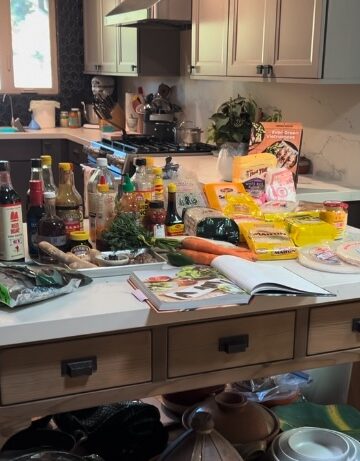
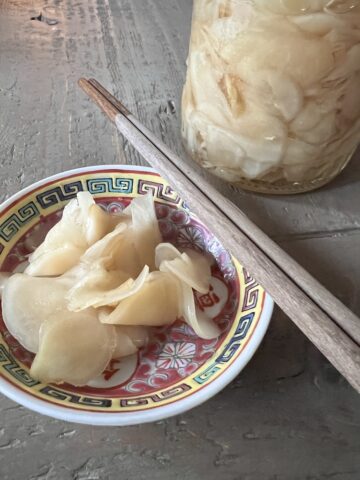
Elizabeth Andoh says
CONGRATULATIONS, Andrea, on your (well-deserved!) best-seller status!!
I find your post on Piper nigrum (black pepper) especially interesting because they are hermaphroditic (the plant is both male & female). Japanese SANSHŌ berries (Zanthoxylum piperitum), in contrast, are harvested from female plants -- females that have grown in symbiotic bliss with male plants. Male plants produce flowers; both produce edible leaves (called kinomé). I just did a TASTEofCULTURE Facebook post on SANSHŌ.
Andrea Nguyen says
Thank you, Elizabeth! As a cookbook author, you know what those bestseller lists are about.
There's a wild betel leaf (Piper sarmensotum) that's eaten raw or cooked in Vietnamese and Thai cuisine. It has an incense-like aroma. I think I've had kinome before. Love what you provided about sexy sansho! http://www.kanshacooking.com/lesson-eighteen-sansho.php
Elizabeth Andoh says
Hmm... sounds like I need to find some wild betel leaf (Piper sarmensotum) in Tokyo. Incense-like aroma sounds intriguing!
Andrea Nguyen says
I'll get it for you next time you're in America!
Karen Vanarsdel says
When I visited Vietnam several years ago I bought 4 kilos of pepper, two black and two white. I bought them in a small place in Can Tho. There was a lady with a large tub of peppercorns. She was running her hands through them looking for foreign objects. I had an interesting conversation with her about the different peppercorns that she offered in her shop. She was obviously really into it and I loved the way her eyes lit up when she told me about the peppercorns from Phu Quoc. I don't recall where she said the white peppercorns came from. I brought my bounty home and put it in the freezer, tightly sealed in double freezer bags. After a couple of years in the freezer they did finally loose their zip but every time I filled my grinders I was back there in a little shop in Can Tho chatting with a lady about peppercorns.
Andrea Nguyen says
Yowza, that's like close to 10 pounds! Yeah, the pepper do lose a little in the freezer but the memories never fade. Thank you for sharing that story, Karen!
Leonie says
Fascinating to read about Vietnamese peppers!
I knew nothing about the wide variety of peppers until last spring I was on holiday in Provence, and in the village weekly market there was a spice stall with a wide range of peppers. The owner was a real enthusiast and kindly talked me through all her range and gave me samples to taste. I bought a couple, with my favourites being "wild pepper" and Nepalese Timur pepper. The Timur pepper, related to the Szechuan pepper, has an amazing fruity zing with a distinct aroma of passion fruit. By coincidence I ended up visiting Nepal a couple of months after on a work trip, and have learned how to use the Timur pepper in Nepalese dishes from a colleague.
I live in London and have access to a lot of different imported foods quite easily, but it was a real discovery to learn about all those peppers, in kind of an unexpected place in the French countryside! Really widened my culinary horizons. In fact it helped me think about pepper quite differently, as before I only used it very sparsely.
If you haven't tried it before, then I recommend getting some Timur pepper!
Andrea Nguyen says
Thanks for contributing information from London. I'll look for Timur pepper!